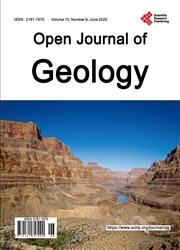How a New Geology and Glacial Paradigm Explains Colorado South Platte-Arkansas River Drainage Divide Topographic Map Evidence, USA
引用次数: 2
Abstract
United States Geological Survey (USGS) topographic maps (available at the USGS National Map website) are used to determine development of the asymmetric South Platte River drainage basin (south of Denver) by noting low points (referred to as divide crossings) where south-oriented floodwater channels once crossed the South Platte-Arkansas River drainage divide. Twelve groups of observed divide crossings are described most of which show evidence for flood-formed diverging and converging channels including where divide crossings are cut across Thirtynine Mile volcanic field ejectamenta. A new Cenozoic geologic and glacial history paradigm requires southeast- and south-oriented floods to have flowed across what is now the east-west continental divide to reach the southeast-oriented Arkansas River valley and to have eroded the divide crossings before north-oriented South Platte River valley headward erosion captured the flow. Such floods are not consistent with accepted Cenozoic geologic and glacial history interpretations, but are consistent with new paradigm interpretations (developed to explain Missouri River drainage basin topographic map drainage system evidence) in which a thick continental ice sheet (located where large continental ice sheets are usually reported to have been) deeply eroded the underlying bedrock and caused crustal uplift to create a deep “hole” with a deep “hole” rim segment roughly following today’s Wyoming and northern Colorado east-west continental divide and then continuing eastward along what is now the Mis-souri-Arkansas River drainage divide. The new paradigm results in a Cenozoic geologic and glacial history in which immense south-oriented continental ice sheet meltwater floods first flowed in a south direction across the rising deep “hole” rim and were then forced by rim uplift to flow along the rim subsequently in north directions into the developing deep “hole”.一个新的地质和冰川范式如何解释科罗拉多南普拉特河-阿肯色河流域的地形图证据,美国
美国地质调查局(USGS)的地形图(可在USGS国家地图网站上获得)用于确定不对称的南普拉特河流域(丹佛以南)的发展,通过记录向南的洪水通道曾经越过南普拉特河-阿肯色河流域分水岭的低点(称为分水岭交叉点)。本文描述了12组观测到的分岔道口,其中大多数显示了洪水形成的分流和汇合通道的证据,包括分岔道口在39英里火山场喷出物上切割的地方。一个新的新生代地质和冰川历史范式要求东南和南向的洪水穿过现在的东西大陆分水岭,到达东南方向的阿肯色河谷,并在向北的南普拉特河谷上游侵蚀之前侵蚀了分水岭的交叉点。这样的洪水与公认的新生代地质和冰川史解释不一致,但与新的范式解释(开发用于解释密苏里河流域地形图排水系统证据)一致,其中厚厚的大陆冰盖(位于通常报道的大型大陆冰盖的位置)深深地侵蚀了下面的基岩,并引起地壳隆起,形成一个深“洞”,其深“洞”边缘部分大致与今天的怀俄明州和科罗拉多州北部东西大陆分裂一致,然后继续向东沿着现在的密苏里-阿肯色州河分水岭。新范式导致了一个新生代地质和冰川史,在这个冰川史中,巨大的南向大陆冰盖融水首先向南流过上升的深“孔”边缘,然后在边缘隆起的作用下沿着边缘向北流入发育中的深“孔”。
本文章由计算机程序翻译,如有差异,请以英文原文为准。
求助全文
约1分钟内获得全文
求助全文

 求助内容:
求助内容: 应助结果提醒方式:
应助结果提醒方式:


